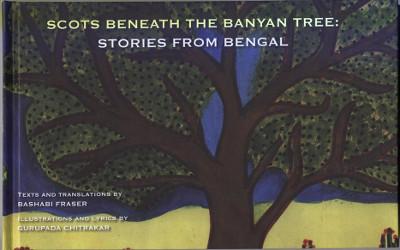
The book contains 8 real life stories collected by Bashabi Fraser that gives us a glimpse of history often submerged in the light of modern forays. The stories are about Scots who came to India during the period from 1707 -1947, a period of 240 years. It was the time when the East India Company, a joint stock trading company of the British, came to India to trade in salt, indigo dye, salt petre, tea, opium and cotton. What followed id not of interest to me at this point in time, but the fact that they left behind many enterprises that dominated the Indian economy and left a mark on the Indian people as well.
It tells of the spirit of the Scotsmen who merged their lives in the environment they lived in and pioneered many a contribution. When people trans-locate for any reason, justifiably or otherwise, they could over the millennia, be forgotten, their memories buried with the dust that they are interred in. In this effort to tell the stories of the 8 Scotsmen who left their footprints on the sand of time, many a historical tale is told.
There is the story of William Roxburgh, who even as a medical surgeon extended his skills to gather and identify several specimens of indigenous plant species from diverse regions. With specimens soon touching the 3500 number he verily has reason to establish the Kolkata Botanical Gardens that houses ‘The Great Banyan Tree’.
“At Madras Hospital his interest in plants led to a vast collection from different parts. But a hurricane destroyed his collection, and so, Roxburgh had to think of another direction.”
Hamilton Sahib remains a household name, who invested in the welfare of Bengal’s disposed. In the land of Sunderbans ‘the people were ridden with superstition, So Hamilton decided on their education.” “ He constructed canals for irrigation and dug wells for the population”. “He was like Ashoka, King of ancient India, who saw his subject’ misery and thought of their welfare”.
Fondly called ‘Hare Sahib’ was David Hare. “Of David Hare’s work in introducing education that was secular, liberal and beyond religion”. What stands as ‘Presidency College’ in Kolkata today is considered a premier institute.
The Railway system was introduced by James Bruce, Lord Elgin as he was known. He laid across the plains of India, a network of railroads to assist trade”.
Alexander Duff, a missionary, became an active participant in the Bengal Renaissance and his name survives in Duff Church, Duff School and Duff scholarships. “He established The General Assembly Institution which was dedicated to women’s education”.
Andrew and George Yule have remained in public memory to this day for their entrepreneurship.
“George took a deep interest in the Indian politics, became sheriff of Calcutta in 1886. As India was swept with the wave of nationalism George joined the movement with enthusiasm”.
My favourite personality is Dr. Ronald Ross. As a young child living in Secunderabad, my father, a doctor, had often driven us past the house where he lived, totally inspired by his work. On July the 4th he was able to find the strand of malaria in the anopheles’s salivary gland.
Fraserganj is well known for its silver beach, after Andrew Henderson Leith Fraser, a former Lieutenant Governor of Bengal. He established a resort centre which the people built and a health centre for villagers in need of treatment as he wanted to extend care to all inhabitants
The narrative and the lyrical style of the book is delightful to read. The mind just flows through yesteryears to think of the souls who felt for their fellowmen and did their bit.
Read, enjoy and pick up a bit of gratifying history.
And now something about the illustrations. Created in the form of an actual patua scroll that opens up, makes the book very special and enjoyable to browse through. Among the any distinct art forms that prevailed among the tribal’s in India, ‘Patuas of Bengal’ are noteworthy. It could verily be described as perhaps the earliest attempt in the audio- visual genre as it comes with scrolls of graphics detailing the story to be told to be accompanied by lyrics specially written for the context. Those that undertook the art for were called ‘chitrakars’. In Bengal legend has it that the Lord of creativity ‘Vishwakarma’ had nine children each of whom were torchbearers of the nine artisan communities. The youngest son took to Pata Chitras. In seeking better opportunities in life the pata Chitrakars embraced Islam, but maintained their dual identity, painting stories for Hindu mythology as well. The distinction was that they always added their profession as their last name and added Chitrakar at the end of their names. The images they created were vibrant and bold and the depictions were simple yet arresting. They were also topical in that they moved with times and narrated through their lyric and imagery any contemporary theme. Hence it is no surprise that when they found the opportunity inviting them to sing about a contribution that has historical significance they did not batter an eyelid before they stretched their pen and mind together.